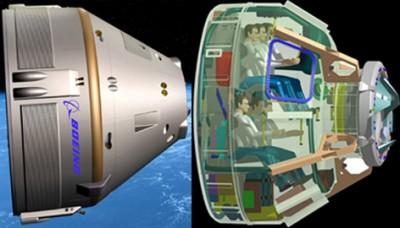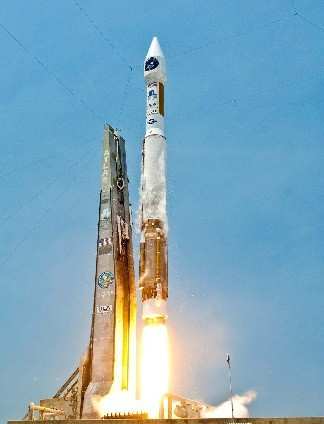Sat, Sep 15, 2012
Integrated Systems Review Proposes CST-100 Spacecraft Boosted By An Atlas V Launch Vehicle
The Boeing Company has completed its first performance milestone for NASA's Commercial Crew Integrated Capability (CCiCap) initiative, which is intended to lead to the availability of human spaceflight transportation services for government and commercial customers. In its Integrated Systems Review (ISR), Boeing presented the latest designs of its CST-100 spacecraft, United Launch Alliance's Atlas V rocket launch system, and ground and mission operations. These designs will serve as the baseline for further development work to be accomplished during CCiCap. The company also discussed its plans for safety and mission assurance, which ultimately will contribute to achieving certification of the system for human spaceflight.

"The ISR established a firm baseline configuration that will allow our team to push forward with the final vehicle design", said John Mulholland, Boeing vice president and program manager for Commercial Programs. "We hope the rigor of our design and development process, and our outstanding team of suppliers will help position the CST-100 as one of the next crew transportation vehicles to the space station and other low Earth orbit destinations."
Technical experts from NASA's Commercial Crew Program (CCP) participated in the review in Houston. They are in the process of providing comments and advice based on more than 50 years of human spaceflight experience.

"All of our industry partners are gearing up to push their human spaceflight technologies further than ever before so America can have its own crew transportation system around the middle of the decade," said Ed Mango, CCP's program manager. "This review was just the first of many exciting and valuable milestones Boeing is expected to complete during its funded partnership with NASA."
At the review, Boeing also presented results from numerous tests that were conducted as part of its earlier Commercial Crew Development Round Two Space Act Agreement with NASA. These tests included parachute and air bag drops, abort engine firings and wind tunnel tests. NASA's new CCiCap agreements follow two previous commercial endeavors by the agency to spur the development of crew transportation systems and subsystems. Work by NASA's industry partners during CCiCap will set the stage for a crewed orbital demonstration mission around the middle of the decade.
Future development and certification initiatives eventually will lead to the availability of human spaceflight services for NASA to send its astronauts to the International Space Station. The overall goal of NASA's commercial space efforts is to make low Earth orbit more accessible and open for business for other government and commercial customers.
(Images Top Boeing CST-100, Bottom ULA Atlas V launch)
More News
Terminal Radar Service Area Airspace surrounding designated airports wherein ATC provides radar vectoring, sequencing, and separation on a full-time basis for all IFR and participa>[...]
Very High Frequency (VHF) The frequency band between 30 and 300 MHz. Portions of this band, 108 to 118 MHz, are used for certain NAVAIDs; 118 to 136 MHz are used for civil air/grou>[...]
“From approximately November 2021 through January 2022, Britton-Harr, acting on behalf of AeroVanti, entered into lease-purchase agreements for five Piaggio-manufactured airc>[...]
Also: Virtual FLRAA Prototype, IFR-Capable Autonomous A/C, NS-32 Crew, Golden Dome Missile Defense Bombardier announced that the first production Global 8000 successfully completed>[...]
Aero Linx: The 1-26 Association (Schweizer) The Association’s goal is to foster the helpfulness, the camaraderie, and the opportunity for head-to-head competition that is fou>[...]
 ANN's Daily Aero-Term (05.29.25): Terminal Radar Service Area
ANN's Daily Aero-Term (05.29.25): Terminal Radar Service Area ANN's Daily Aero-Term (05.30.25): Very High Frequency (VHF)
ANN's Daily Aero-Term (05.30.25): Very High Frequency (VHF) Aero-News: Quote of the Day (05.30.25)
Aero-News: Quote of the Day (05.30.25) Airborne 05.23.25: Global 8000, Qatar B747 Accepted, Aviation Merit Badge
Airborne 05.23.25: Global 8000, Qatar B747 Accepted, Aviation Merit Badge ANN's Daily Aero-Linx (05.30.25)
ANN's Daily Aero-Linx (05.30.25)




